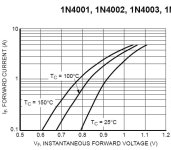BiGH said:
Nimbuzz said:
2 -- PS; A question in this thread that seemed to go unanswered << I don't understand how a diode can reduce voltage though... doesn't a diode push current one way only? .. i didn't thing it can limit voltage .. but voltage drop is i guess what happens when you put 3 diodes in series... steveo -- >>
Thanks for info
I have a limited understanding of this, but here's my guess: Each component in a circuit uses some electricity, each more than others (internal resistance). By using the laws of conservation of energy some of the energy passed through the diode gets turned into heat etc. This is what causes the voltage drop.
http://en.wikipedia.org/wiki/Voltage_drop
i'm probably wrong, but feel free to correct me. I'm starting to get very interested in electronics, especially as I'll be building my own controller for the car soon

.
It's not the resistance at all, and anything resistance related would vary linearly with the amount of current. Once you're passing the needed current level to reach the Vf of the diode (0.7v in this case), it holds that 0.7v drop roughly fixed solid unless you drastically over current the device.
A non-technical way to think about it is like this.
A resistance loss is kinda like an income tax. You lose an amount of your money (voltage) based on the amount of current you're passing. You pass 1amp through something with 1ohm of resistance, you loose 1volt. You pass 10amp, you loose 10volts. You pass 100amps you loose 100v. etc etc
A diode Vf drop is more like a toll booth on a road. If you're driving a $400 geo metro through, you pay your $0.70 toll. If you're driving your 1.5million dollar Bugatti Veyron through the toll booth, you still just pay your $0.7 toll. As long as you don't exceed the current limitations of the diode, you always just pay the 0.7v drop, and it doesn't matter if you're passing 1amp or 100amps (as long as the diode is rated to handle 100amps of course).


